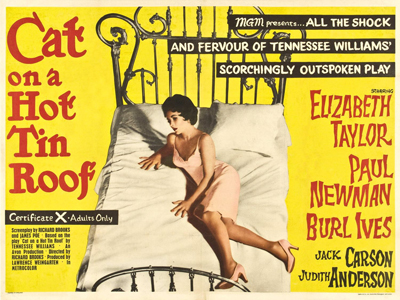Classic Movie Review: Cat on a Hot Tin Roof
By Clint Chirpich
November 8, 2016
Richard Brooks, as a director, seemed to understand the most important aspects of this film were the writing and performances, and he stepped back and allowed them to shine. If Brooks had wanted to put his own spin on the film, it might have backfired, so I'm glad he knew how to use restraint. His work paid off, too, as Cat on a Hot Tin Roof earned him an Oscar nomination for Best Director.
That's not to say Cat on a Hot Tin Roof isn't an interesting film to look at. A great aspect is the gorgeous costume and set design. Since the characters are all wealthy, they are all decked out in beautiful clothes and surrounded by wonderful pieces of furniture in a glorious mansion. There's a scene in the basement with Big Daddy and Brick where they are practically overtaken by antiques and rugs and works of art. I think I could watch the film again and only pay attention to the background details and be almost as entertained as I was while watching the narrative unfold.
The cinematography work by William Daniels - an Oscar winner who had a long career and was equally adept at shooting in black and white and color - is understated, but effective, a lot like Cat on a Hot Tin Roof's direction, now that I think of it. There are some wonderful shots, but when the film you're shooting stars two beauties like Taylor and Newman, those shots are probably going to be overlooked. While watching the film, I couldn't take my eyes off the stars, but while looking back at some stills, I became very impressed with the shot composition and lighting. I especially liked the way Daniels used shadows to help create a mood. Daniels was nominated for Oscar for Best Color Cinematography for Cat on a Hot Tin Roof but lost out to Gigi, the much flashier musical that won nine Oscars that year.
The music, what little there is, is one of the only failings of Cat on a Hot Tin Roof. Since there was a union musicians strike going on at the time, the film wasn't able to get its own personalized score and instead had to use bits of pre-existing music. This in of itself isn't a bad thing, but the way the music was used is what bothered me. For the vast majority of the film, there is no background music at all. When there is music, it swells melodramatically to underscore an emotional moment in the narrative. Very few things irk me as much as cheesy, over the top, unsubtle music. It's especially noticeable in Cat on a Hot Tin Roof as the music kicks in right at the emotional part, as if the audience wouldn't know to be moved by what's onscreen without a forceful nudging from the soundtrack. The music doesn't last long enough to be overbearing, but it's rather obviously manipulative. Honestly, I would have preferred no music to what was actually used.
When I watch a film, I'm much more concerned with the writing - including plot, characters, and dialogue - and the acting performances than with any of the other more technical aspects of filmmaking, so a film like Cat on a Hot Tin Roof is right up my alley. There are no fistfights or explosions, but it's still an exciting film. There's no nudity or sex, but it's still an unbelievably sexy film. And there's nothing otherworldly, exotic, or magical, but it's still a captivating, intriguing film that I hope to return to several more times.
Today, I rarely hear or read anything about it, which is a shame. I think if more people gave it a chance, they'd really enjoy it as I have.
I wish someone would have urged me to check it out sooner.
Consider yourself urged.
Continued:
1
2
3
4
5




